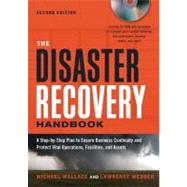
What is included with this book?
MICHAEL WALLACE is VP of Application Engineering at Result Data, an IT strategy, business intelligence, and disaster recovery consulting firm. He is a member of the Contingency Planners of Ohio and the Project Management Institute.
LAWRENCE WEBBER is a Certified Project Manager (CPM), a Master Business Continuity Professional (MBCP), and Director of Programs and Processes for System Design Advantage.
| Getting Started: Overview of the Project | |
| Building the Business Case: Measuring the Impact on the Business | |
| Evaluating Risk: Understanding What Can Go Wrong | |
| Selecting a Strategy: Setting the Direction | |
| Build an Interim Plan: Don't Just Sit There, Do Something | |
| Writing the Plan: Getting It Down on Paper | |
| Administrative Plan: Orchestrating the Recovery | |
| Crisis Management Plan: Minimizing the Damage | |
| Technical Recovery Plan: Putting Humpty Dumpty Back Together Again | |
| Work Area Recovery Plan: Getting the Office Up and Running | |
| Pandemic Plan | |
| Emergency Operations Center: Take Control of the Situation | |
| Testing Your Plans: Test, Test, Test | |
| Electrical Service: Keeping the Juice Flowing | |
| Telecommunications and Networking: Your Connection to the World | |
| Vital Records Recovery: Covering Your Assets | |
| Data: Your Most Irreplaceable Asset | |
| Workstations: The Weakest Link | |
| Customers: Other People to Worry About | |
| Suppliers: Collateral Damage | |
| Fire: Burning Down the House | |
| Human Resources: Your Most Valuable Asset | |
| Health and Safety: Keeping Everyone Healthy | |
| Terrorism: The Wrath of Man | |
| Index | |
| About the Authors | |
| Table of Contents provided by Publisher. All Rights Reserved. |
The New copy of this book will include any supplemental materials advertised. Please check the title of the book to determine if it should include any access cards, study guides, lab manuals, CDs, etc.
The Used, Rental and eBook copies of this book are not guaranteed to include any supplemental materials. Typically, only the book itself is included. This is true even if the title states it includes any access cards, study guides, lab manuals, CDs, etc.